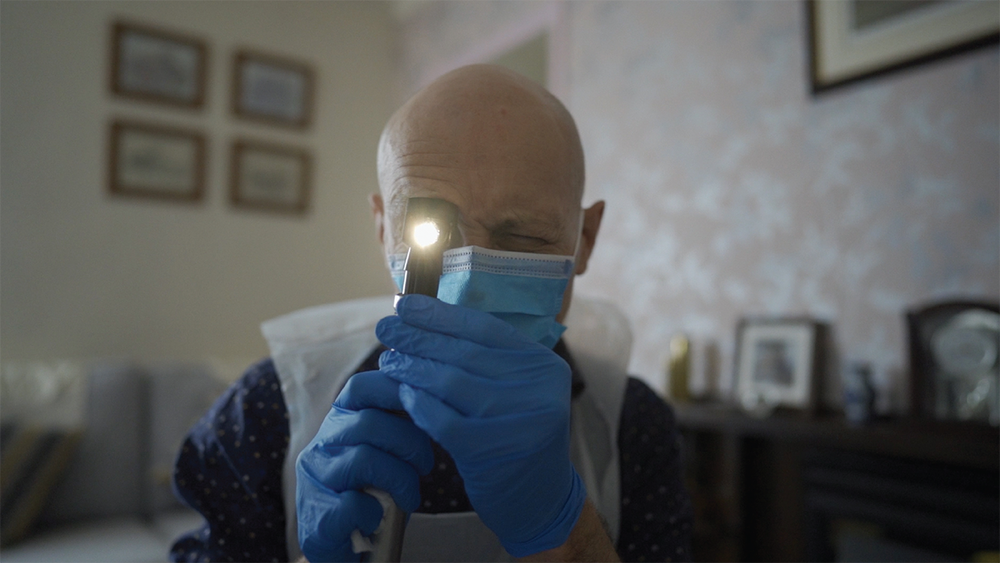You are viewing 1 of your 3 articles before login/registration is required
House Calls
Optimism Health CEO Henry Pitman on advancing the UK’s domiciliary eye care sector
OutsideClinic, the UK’s largest and fastest growing provider of home eye care services, was established in 1987 to ensure equal access to eye and ear health services for patients unable to access the high street. In November 2020, healthcare investment business Optimism Health Group acquired OutsideClinic with a view to expanding the company’s services with new technology solutions, clinical services, and healthcare products in domiciliary settings.
This year, OutsideClinic launched its Discover Domiciliary series of free webinars – including “Introduction To The Exciting World Of Domiciliary Optometry” and “High Street vs. Domiciliary Optometry: The Key Differences” – aimed at providing optometrists with “a 360-degree view of what it’s really like to work in the sector.” (CPD points are available for three out of the four webinars.)
The New Optometrist caught up with Optimism Health founder and CEO Henry Pitman to explore his vision for the future of the domiciliary sector.
How has the demand for domiciliary eye care changed?
There’s been considerable growth in domiciliary in the last two to three years. We have an aging population – and people are living longer with a variety of chronic health conditions. The NHS is encouraging services to be pushed out into the community to take the pressure off the hospital infrastructure. On top of that, there is the COVID effect – older people have got used to services being provided in their own homes, which is more preferable than battling the pouring rain, getting on a bus in the wrong direction, or planning a logistical mission with hoists and wheelchairs and so on. According to the NHS, there are 450,000 people in the UK currently benefiting from domiciliary care.
How are you expanding awareness of the domiciliary sector?
Optimism Health Group acquired Outside Clinic in 2020 and we now have more than 150 optometrists spread across the country; they see about six patients a day in patients’ own homes and one or two more than that in care homes. But there is a big challenge with recruitment. Though it’s quite easy to recruit in some of the major cities like London or Birmingham, it’s very difficult in some of the rural and coastal areas. When you look at supply and demand within the optical industry as a whole, we are several thousand optometrists short in the UK. This is having an impact in the domiciliary sector too. Just look at the major multiples’ websites and you can see how many vacancies there are.
Part of the problem is that domiciliary is not part of optometry education at many universities. We still see people who have been optometrists or opticians for many years but still don’t understand domiciliary. Our webinar program aims to increase knowledge of the sector and discuss aspects of the job that might appeal to optometrists looking for more variety or for more of a challenge. Domiciliary is not something that needs to be full-time, for example; we have optometrists who do three days in the high street and a couple of days’ domiciliary. We also offer a 3-,4- or 5-day working week, with school hour and term time contracts available.
Instead of being sat in an office with no windows, testing multiple patients a day, you can break up your week and go out and meet people in their homes.
From a clinical perspective, domiciliary can be challenging and interesting work because older patients’ eyes can change rapidly. It requires a certain amount of maturity on the part of the optometrist: they have to work on their own, running their own daily schedule, and they have to carry quite a lot of equipment and set it up in people’s homes. So, it can be quite physical, but a lot of people enjoy that aspect.
How has Optimism Health’s acquisition of OutsideClinic advanced its domiciliary activities?
We wanted to keep strengthening the clinical side of the business and build a reputation for having the highest standards. We put a lot of resources into this – we have a fantastic patient record system, for example, which is widely considered to be the best in the domiciliary space.
We’re also trying to create a system that helps optometrists use their time more efficiently, reducing the amount of driving they have to do, for example – but this can only work if there are enough domiciliary optometrists around the country!
We’ve also recently launched a Joint Venture Partnership Model (see Sidebar), providing optometrists with an opportunity to build and run a fully supported domiciliary practice.
We believe there is a great deal of room for expansion in the domiciliary sector; there are nearly three million older patients who are essentially housebound and would benefit from these services. At the moment, we’re seeing around 200,000 of these patients – so there’s quite a way to go.
OutsideClinic’s Paul Chapman Hatchett on the company’s joint venture partnerships
With a view to plugging the “optometrist gap” and ensuring the people most in need of eye care don’t get left behind, OutsideClinic’s joint venture partnership (JVP) model gives optometrists the opportunity to build their business and look after patients while receiving business and administrative support. It allows them to enjoy the independence of being self-employed, while benefiting from the resources available from an experienced company.
The JVP model offers guaranteed client acquisition and management, as well as marketing, sales, accountancy legal, and HR support. Partners are equipped with some of the most advanced portable testing equipment in the industry and have full access to OutsideClinic’s professional services team. Joint venture partners are also able to access the company’s comprehensive CPD program.
Domiciliary was recently cited as the most satisfying sector to work in – and there’s a myriad of flexible working opportunities available to suit all requirements.
Paul Chapman Hatchett, Strategic Partnerships Director
The New Optometrist Newsletter
Permission Statement
By opting-in, you agree to receive email communications from The New Optometrist. You will stay up-to-date with optometry content, news, events and sponsors information.
You can view our privacy policy here
Most Popular
Sign up to The New Optometrist Updates
Permission Statement
By opting-in, you agree to receive email communications from The New Optometrist. You will stay up-to-date with optometry content, news, events and sponsors information.
You can view our privacy policy here
Sign up to The New Optometrist Updates
Permission Statement
By opting-in, you agree to receive email communications from The New Optometrist. You will stay up-to-date with optometry content, news, events and sponsors information.
You can view our privacy policy here









